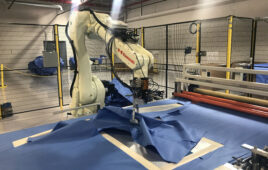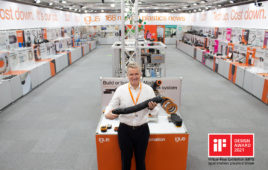 To better understand how global manufacturers are adjusting to the Coronavirus pandemic, we’ve been reaching out to industry thought leaders for their perspective. We recently corresponded via email with Stefan Koveal, Director, Engineering, Diversified Technologies, Southco, Inc. to learn more about how their company is handling the outbreak. Here is his response, edited for length and clarity.
To better understand how global manufacturers are adjusting to the Coronavirus pandemic, we’ve been reaching out to industry thought leaders for their perspective. We recently corresponded via email with Stefan Koveal, Director, Engineering, Diversified Technologies, Southco, Inc. to learn more about how their company is handling the outbreak. Here is his response, edited for length and clarity.
1. Briefly, what modifications has your employer made to working conditions (working remotely, teleconferences, layoffs, increased time off/sick leave, etc.)?
A lot of the industries that Southco serves are considered life-sustaining, so our global factories remain open. We instituted a policy right away where anyone who could work from home would be able to do so. And we set up laptops for people who used a desktop at work and couldn’t get on a computer at home.
In our factories, we immediately implemented a process to take the temperatures of people coming into the building. We’ve also implemented social distancing, with everyone working more than six feet apart. In some cases, we moved workstations to ensure people can spread out.
From the standpoint of projects and keeping them moving, and especially regarding communication with our team and our customers, we really haven’t skipped a beat. Being a global company, we are used to working remotely.
a. Follow-up: As a global manufacturer, how have you adjusted your global operations in response to COVID-19? What changes, where, and when?
In many ways, being a global manufacturer has benefitted us – it allows us to set up global systems and process and leverage factories outside of affected areas. For example, we have design and manufacturing operations in China. They were the first to get hit. So, we immediately jumped in to support them: shipping masks and PPE because they couldn’t get it, helping them with checking our associates’ temperatures. And then, when they shut down, we moved work to some of our other factories that weren’t initially affected. Now, as things are hitting in the West, China is getting better and is, therefore, able to help us.
2. Assuming roughly two months of this “new normal,” how much of an impact do you think there will be on your day-to-day work, projects, etc.?
We’re actually finding increased productivity from our associates. Instead of getting involved in side projects, meetings, or other distractions at the office, they’re able to focus more.
In addition, a lot of people are flexing their hours to be able to accommodate being parents and partners. So, as much as we can, we’re trying to be flexible and understanding of the different dynamics people face while working at home.
3. What are some of the initiatives that your company has taken to protect workers while maintaining the business? On the factory floor? In the office? In the warehouse?
We’re trying to stop sick people before they even walk into our buildings, and implemented a travel ban months ago. In addition, we’ve been following the CDC recommendations; including making sure people don’t come in when sick. For example, in our Worcester, UK facility, we’ve automated a temperature check right at the time clock. So, when associates go to the time clock and swipe in their badge, it won’t recognize or record the swipe until their temperature has been checked at that station.
Most of our factories are large and have plenty of space. We’re highly automated, which also helps reduce the number of employees on the factory floor. On assembly lines where people are working next to each other, we’ve had to get creative and change things. For example, in cases where we can’t ensure people are six feet apart, we put a partition between people to ensure they’re shielded from each other. Then, during shift changes, we disinfect these areas when we switch from one person to another.
For our office staff, many people are working from home. When we can’t do something at home – trying to get parts out, crafting prototypes, designs, and testing – we have a system where the management team and the staff handling temperature checks and log-ins are notified that someone needs to be in the office. We usually set a predefined schedule for them to come in and we try to limit the number of people in the office at the same time.
4. How do you think your job, in particular, can be handled during times of restricted personal interactions like these? What successes are you having in working with teams remotely?
We keep in touch with our teams and just see what’s going on – not just with their projects but also in their personal lives. You really need to see and get the barometer of the individual and what they’re dealing with, and bring that into the equation. At Southco, we’re very employee-centric, and it’s no different now. This is something that will continue.
From a project perspective, when we need to call a meeting together, we get online, we get on the phone and do everything we normally would if we were physically in the office. With the technology we have available, we can still have an impromptu face-to-face meeting electronically. We’re fortunate to have the infrastructure to be able to do that.
With global teams in different areas, we’re used to managing things remotely. However, we can’t travel now, so we have to make up for that by having more interaction, more daily calls, and more nighttime calls as a global company (i.e., the US team is calling the Asia team during their day, which is our night).
Lastly, it’s the little things. Maybe sending an employee some food for an evening dinner via DoorDash, just to make sure they still understand we’re here, and we appreciate the effort they’re putting into their work to maintain business as usual.
5. What are some tips and tricks your team has discovered/implemented?
One thing we’re having a lot of fun with right now is a special program set up by our Human Resources Development team to honor our facility workers. They are inviting the office staff to take a picture at home with a thank you sign or some kind of appreciation gesture. Every other day, the HR team sends out a thank you email, blasting it through the company with a few of those pictures. The first picture was of our CEO in his home office with a big sign on his computer saying, “Thank you, team, for your hard work.” We see people posing with their pets, too, and it’s a lot of fun seeing people in their home environment. Just sending those around has been great for morale.
6. How are you maintaining employee productivity? What about mental health/worker morale? Where’s your focus there?
We’re constantly asking about our associates’ families, what we can do and if there’s anything on their minds. We try to help the individual person – getting to know the individual is critical in any business but especially now. Even stepping in to offer a helping hand, knowing that no job is too small or below anyone to pitch in is important. This also helps productivity because people know we care. We’re not just sitting somewhere throwing things at them; we actually care.
We’re a scorecard-driven company and through these metrics, our team hasn’t skipped a beat over the last two months of shutdown. We aren’t missing deadlines. Of course, some orders have flattened but our production hasn’t suffered.
7. How do you think engineers can maintain their creativity during these times of limited physical interaction with other team members?
What we’re seeing is that we don’t have to drive that. Individuals are accomplishing tasks on their own … setting meetings, asking questions, etc. We miss getting around a whiteboard and brainstorming but it can still be done virtually (and verbally).
From a well-being standpoint, we have a fantastic employee assistance program. Every day, our HR team sends messages to ensure our team knows where and how to get help if they need it. And we have a dedicated employee assistance program to help with that, too.
8. What message(s) do you wish to give to colleagues across the manufacturing world at this time? (encouragement, warnings, helpful advice, etc.)
Having globally integrated systems and a strong IT infrastructure allow you to adapt more easily to situations like this. It takes an investment but if you’re not moving toward these global processes, you need to be. So, for example, if a facility in one part of the world gets shut down, we can transfer to another facility and get it up and running in a very short amount of time because we have the same procedures, the same formats, and the same processes. And it’s very easy to move something from one place to another. We’ve been building our manufacturing infrastructure so it operates in the same way everywhere. For example, if you walked through our Concordville, PA, plant, and put on a blindfold, I could take you to our Shanghai, China plant, ask you to take off the blindfold and you wouldn’t be able to tell the difference between the two plants.
That flexibility and connectivity have other benefits, too. It allows us to see our operations globally, so we can tell when a machine is running, or the efficiency in China or Europe when we’re here in Pennsylvania. We have that connectivity not only from the engineering side but also the business, sales, and operations sides. Financially speaking it’s an investment, but in situations like this, it’s been really helpful – much of what we’ve been able to do during the pandemic we wouldn’t be able to do otherwise.
9. How are you allowing engineers to gain access to simulation software and data from outside the company firewall?
We have an internal firewall and VPNs (virtual private networks) to which we all have access. Everything is password protected and locked up and no one is working through their local, home Internet. They’re all working through a Southco VPN.
10. What seems to be the main threats to your supply chain right now?
Having two suppliers for every process and not being single-sourced for anything is important for flexibility in situations like this. If one resource goes down, you can move work to another pretty quickly. It’s also important to have suppliers in each region to avoid being dependent on a single source.
Performing regular risk assessments is also part of our strategy – and part of our IATF certification for the Automotive industry, which serve through our Concordville, PA facility. We’re AS9100 certified for Aerospace as well, and we perform risk assessments to ensure that if a supplier has a catastrophe, we have a contingency plan in place to serve these industries. That planning ahead is important. We face challenges like anyone else and we’ve had to shift and reroute processes or make parts in one place and ship to another for assembly.
Being connected is key. It’s always been part of our culture to stay close – and stay connected – to our team. The way we work has changed but our manufacturing philosophy remains the same.
Southco
southco.com
Filed Under: Fighting COVID-19




